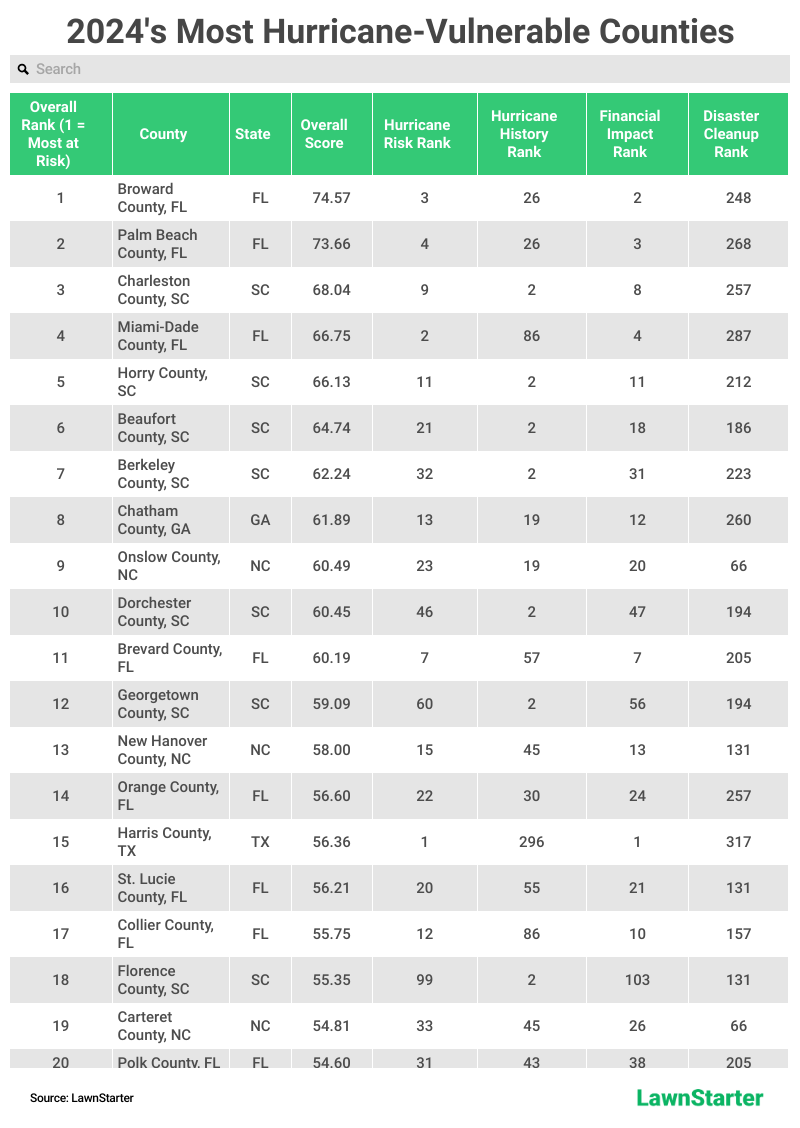Which U.S. counties are most likely to be impacted by hurricanes?
The most hurricane-vulnerable counties in 2024
With a hectic hurricane season forecasted for this summer, LawnStarter ranked 2024's most hurricane-vulnerable counties.
The rankings considered hurricane risk assessments and anticipated financial loss from hurricanes according to the Federal Emergency Management Agency (FEMA). It also included the past 10 years of historical storm data from the National Oceanic and Atmospheric Administration (NOAA) and access to national disaster debris recovery facilities.
To learn how the counties are ranked, read the methodology.
County Rankings
See how the top 20 counties fared in our ranking:

LawnStarter
Top 5 Close Up
No. 1: Broward County, Florida | 3 Biggest Cities: Fort Lauderdale, Pembroke Pines, and Hollywood
- Overall Score: 74.57
- Hurricane Risk Score: 99.91 | Rank: 3
- Total Number of Hurricanes (Last 10 Years): 9 | Rank: 25 (tie)
- Number of Category 5 Hurricanes (Last 10 Years): 4 | Rank: 1 (tie)
- Expected Annual Loss from Hurricanes: $895 million | Rank: 2
- Number of National Disaster Debris Recovery Facilities (EPA 2023): 18 | Rank: 248
No. 2: Palm Beach County, Florida | 3 Biggest Cities: West Palm Beach, Boca Raton, and Boynton Beach
- Overall Score: 73.66
- Hurricane Risk Score: 99.87 | Rank: 4
- Total Number of Hurricanes (Last 10 Years): 9 | Rank: 25 (tie)
- Number of Category 5 Hurricanes (Last 10 Years): 4 | Rank: 1 (tie)
- Expected Annual Loss from Hurricanes: $864 million | Rank: 3
- Number of National Disaster Debris Recovery Facilities (EPA 2023): 27 | Rank: 268
No. 3: Charleston County, South Carolina | 3 Biggest Cities: Charleston, North Charleston, and Mount Pleasant
- Overall Score: 68.04
- Hurricane Risk Score: 99.64 | Rank: 9
- Total Number of Hurricanes (Last 10 Years): 11 | Rank: 2 (tie)
- Number of Category 5 Hurricanes (Last 10 Years): 4 | Rank: 1 (tie)
- Expected Annual Loss from Hurricanes: $358 million | Rank: 8
- Number of National Disaster Debris Recovery Facilities (EPA 2023): 22 | Rank: 257
No. 4: Miami-Dade County, Florida | 3 Biggest Cities: Miami, Hialeah, and Miami Gardens
- Overall Score: 66.75
- Hurricane Risk Score: 99.96 | Rank: 2
- Total Number of Hurricanes (Last 10 Years): 8 | Rank: 54
- Number of Category 5 Hurricanes (Last 10 Years): 3 | Rank: 48
- Expected Annual Loss from Hurricanes: $832 million | Rank: 4
- Number of National Disaster Debris Recovery Facilities (EPA 2023): 43 | Rank: 287
No. 5: Horry County, South Carolina | 3 Biggest Cities: Myrtle Beach, Conway, and Carolina Forest
- Overall Score: 66.13
- Hurricane Risk Score: 99.55 | Rank: 11
- Total Number of Hurricanes (Last 10 Years): 11 | Rank: 2 (tie)
- Number of Category 5 Hurricanes (Last 10 Years): 4 | Rank: 1 (tie)
- Expected Annual Loss from Hurricanes: $257 million | Rank: 11
- Number of National Disaster Debris Recovery Facilities (EPA 2023): 10 | Rank: 212
Key Insights
Florida and South Carolina account for half of the 100 most hurricane-vulnerable counties.
Harris County, Texas (No. 15), home to Houston, has the highest Hurricane Risk and Expected Annual Loss from Hurricanes — over $1.15 billion, according to FEMA. However, the county ranks behind 277 counties for the overall number of hurricanes — with four total — over the past 10 years. The Houston region has a high susceptibility to flood damage and saw record levels of rainfall during Hurricane Harvey.
All counties in our ranking have some risk of hurricanes and their effects, like flooding. Of these counties, those with the lowest risk of being impacted include Kennebec County, Maine (No. 315), which scored near the bottom alongside Texas counties DeWitt (No. 316) and Bexar, home to San Antonio, in last place.
Methodology
First, we determined the factors (metrics) that are most relevant to rank the Most Hurricane-Vulnerable Counties. We then assigned a weight to each factor based on its importance and grouped those factors into 4 categories: Hurricane Risk, Hurricane History, Financial Impact, and Disaster Cleanup. For each of the 317 U.S. counties with a Hurricane Risk Score determined by FEMA, we then gathered additional data on each factor from the Environmental Protection Agency, Federal Emergency Management Agency, and National Oceanic and Atmospheric Administration.
Finally, we calculated scores (out of 100 points) for each county to determine its rank in each factor, each category, and overall. A county's Overall Score is the average of its scores across all factors and categories. The highest Overall Score ranked "Best" (No. 1) and the lowest "Worst" (No. 317).
Final Thoughts: Weathering the Storm
Climate change is causing hurricanes to strengthen with higher ocean temperatures boosting storm intensity.
As El Niño comes to an end, weather experts at the National Oceanic and Atmospheric Administration are anticipating eight to 13 hurricanes along the Atlantic this year. As many as seven may be major (category 3–5) hurricanes.
While FEMA is incentivizing states to adopt more storm-resilient building codes, predictions show that they could run out of money for disaster relief efforts this year in the middle of hurricane season. Similar circumstances occurred last summer leading to a pause on 2,400 rebuilding projects.
With FEMA's budget stretched thin, emergency shelters may be underfunded, and rebuilding efforts could be slowed after natural disasters strike.
Do what you can to stay safe and prepared for a stormy summer with more tips below.
- Make an evacuation plan for yourself and your loved ones — including pets and livestock.
- Check your emergency supplies and have a "go bag" on hand.
- Be alert and prepared with help from national resources.
- Get financially prepared with flood insurance and see if your gutters are covered by your home insurance policy.
- Invest in hurricane-resistant landscaping.
- Be ready to pick up yard debris and help your lawn recover from flood damage after a hurricane hits.
- Improve your yard's drainage capabilities to prevent flood damage caused by heavy rainfall.
- Clean and repair your gutters for optimal drainage during intense rainstorms.
- Get your roof ready for hurricane season by scheduling a roof inspection.
This story was produced by LawnStarter and reviewed and distributed by Stacker Media.
More Articles to Read

